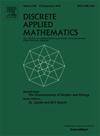An exact algorithm for the adjacent vertex distinguishing sum edge coloring problem
IF 1
3区 数学
Q3 MATHEMATICS, APPLIED
引用次数: 0
Abstract
In this work we define the adjacent vertex distinguishing sum edge coloring problem. This problem consists of finding an assignment of colors to the edges of a graph with the following constraints: every pair of adjacent edges must have a different color, and every pair of adjacent vertices must not have the same set of colors assigned to the edges incident to each. The goal is to minimize the sum of the colors in an edge coloring that satisfies these constraints. This problem is a special case of a large family of problems known as graph labeling, which is a widely used and very popular set of tools to build abstract models for problems that arise in everyday life.
Some variants of graph labeling problems have been successfully addressed with mixed-integer linear programming (MIP) techniques based on a polyhedral characterization of the set of feasible solutions. We use this approach to develop a Branch and Cut algorithm to solve the problem.
We propose two MIP models that are computationally evaluated to choose the most promising one and continue with a polyhedral study. This analysis aims to characterize valid inequalities that strengthen the formulation in the hope of improving the algorithm’s performance. These inequalities are added on demand as cutting planes using exact and heuristic separation algorithms. Additionally, we considered the use of an initial heuristic and a specific branching strategy.
The results show that the algorithm developed allows us to solve instances that were unsolvable using general-purpose solvers. Our polyhedral study and the addition of cutting planes have proved to be crucial factors in solving the most challenging instances.
邻顶点区分和边着色问题的精确算法
在此工作中,我们定义了相邻顶点区分和边着色问题。这个问题包括在以下约束条件下为图的边缘分配颜色:每对相邻的边必须有不同的颜色,每对相邻的顶点不能有相同的颜色分配给每条边。目标是最小化满足这些约束的边缘着色中颜色的总和。这个问题是被称为图标注的一大类问题的一个特例,图标注是一组广泛使用且非常流行的工具,用于为日常生活中出现的问题构建抽象模型。基于可行解集的多面体表征的混合整数线性规划(MIP)技术已经成功地解决了图标注问题的一些变体。我们利用这种方法开发了一个分支和切割算法来解决这个问题。我们提出了两个MIP模型,并进行了计算评估,以选择最有前途的模型并继续进行多面体研究。本分析旨在描述有效的不等式,以加强公式,希望提高算法的性能。使用精确和启发式分离算法按需添加这些不等式作为切割平面。此外,我们还考虑了初始启发式和特定分支策略的使用。结果表明,所开发的算法使我们能够解决使用通用求解器无法求解的实例。我们的多面体研究和增加切割平面已被证明是解决最具挑战性实例的关键因素。
本文章由计算机程序翻译,如有差异,请以英文原文为准。
求助全文
约1分钟内获得全文
求助全文
来源期刊

Discrete Applied Mathematics
数学-应用数学
CiteScore
2.30
自引率
9.10%
发文量
422
审稿时长
4.5 months
期刊介绍:
The aim of Discrete Applied Mathematics is to bring together research papers in different areas of algorithmic and applicable discrete mathematics as well as applications of combinatorial mathematics to informatics and various areas of science and technology. Contributions presented to the journal can be research papers, short notes, surveys, and possibly research problems. The "Communications" section will be devoted to the fastest possible publication of recent research results that are checked and recommended for publication by a member of the Editorial Board. The journal will also publish a limited number of book announcements as well as proceedings of conferences. These proceedings will be fully refereed and adhere to the normal standards of the journal.
Potential authors are advised to view the journal and the open calls-for-papers of special issues before submitting their manuscripts. Only high-quality, original work that is within the scope of the journal or the targeted special issue will be considered.
 求助内容:
求助内容: 应助结果提醒方式:
应助结果提醒方式:


